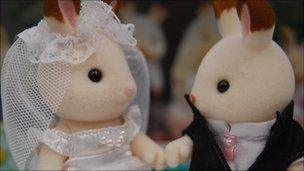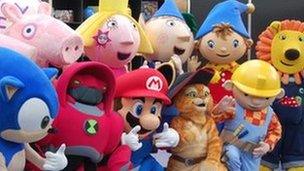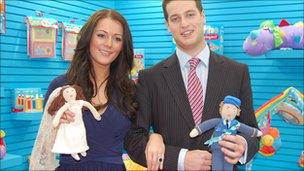Can toys stand the test of time?
- Published
- comments
A month on and it languishes at the back of the cupboard, untouched for weeks - not the leftover cake, but the must-have toy for Christmas 2010.
Frustrated parents will have watched their children lose patience or worse, dismantle their present just hours after unwrapping it.
Yet other youngsters will refuse to sleep, eat or go out without their favourite furry animal for years during childhood.
So, as families watch the pennies, are toys being built to last throughout tough economic times?
Or are they just here today, gone tomorrow fashion items based on the latest trends and prone to breaking after one session of boisterous play?
Fair trade
At the British Toy and Hobby Association's (BTHA's) annual toy fair at London's Olympia exhibition centre, visitors can bump into somebody dressed as a children's film, television or cartoon character at every turn.
The characters wave enthusiastically ... generally at men in suits. This is, after all, a trade fair and not a toy shop.
With business being done, every pitch in the hall sold, and the fair growing on last year, there is little sign of austerity. The BTHA released figures on the first day of the fair suggesting that sales in 2010 were back to 2008 levels.
But the industry, in line with retailers as a whole, accept that the run-up to Christmas was tough. The snowy weather hit sales, and fed into the shrinking UK economy as a whole in the final quarter of the year.
The success story of Christmas was Lego's range linked to the Toy Story film. During the year, the football World Cup gave a boost to outdoor and sports ranges.
This link to fashionable licences - many businesses are already planning Olympics ranges - suggests that retailers are less likely to stock a toy with universal appeal that can be bought and kept for years. Instead they would want parents to keep going back to buy the latest trendy toy.
But this is not always the case, according to Christine Nicholls, who chairs the BTHA.

One significant event of 2011 has inspired a series of new toy ranges
"The traditional or retro market continues," she says.
"There is the much-loved Teddy or favourite character who follows a child through life."
At one end of the hall, Playmobil have decided to steer clear of licensed characters, hoping for a lift from nostalgia.
"Obviously we would love parents to buy a new one, but if they have a pirate ship in the loft, we would like them to buy their children new pirate sets to go with it," says marketing manager Jamie Dickinson, as a remote-controlled car whizzes around his feet.
"There is no negativity in longevity."
The same logic is on display at the John Crane stand at the other end of the hall, featuring a dolls house which sells for £120 and is built to last.
Safety
Yet, the rules and regulations that govern the sale of toys - and there are many - are focussed on safety, rather than the longevity of toys.

Many toys are based on popular characters from films and television
Jerry Burnie, toy safety adviser with the BTHA, says that a toy that breaks easily will not be popular with parents, even if it is not dangerous.
"Toys are often fashion-led, but a lack of quality will mean that a brand is not going to last," he says, in one of the few quiet corners of the exhibition hall.
These rules are to get stricter in 2011, with the introduction of a European directive on toy safety in the UK in July.
This will tighten up the rules of toys being sold with food. There will be no more little figures tucked away, unpackaged, at the bottom of a cereal box.
But the key factor in these rules is that each toy must have go through a safety assessment - and these tests must be fully and routinely documented.
While this might sound reassuring for parents, this testing might need to be outsourced to an independent lab. This will be expensive and could add to the cost of the toys.
It could also prove to be a particular burden for small businesses trying to enter the industry which is already dominated by manufacturers from China.
In 1968, Mr Burnie says, there was a 16-page standard set of regulations for toy safety. At the last count, a single electrical figurine was subject to regulations running to 1,692 pages.
Royal encounter
One character that has always been popular among young girls is the princess - and a new one is in the offing in the UK.

These lookalikes were at the fair promoting a knitted doll kit
In 2011, the fashionable and the traditional will merge for the Royal Wedding of William and Kate.
The relatively short period of time between the announcement of the engagement and the wedding day has caused a bit of a problem for toy manufacturers trying to get in on the act.
But this has not prevented the sudden wedding of William and Catherine - not the Royal couple, of course, but the members of the "chocolate rabbit" branch of Sylvanian Families.
The collectable dolls have proved to be extremely popular with young girls, and the new collection arrives - complete with a vicar, page boy and flower girl - in time for the wedding in April.
"We already had a wedding set, but the groom looked a little like he was in an Elvis outfit. So, we have redeveloped it," says product manager Vanya Hunter.
She will be hoping the toys, and the Royal marriage, are not just fashionable but also stand the test of time.